Polish "Crabs". 155 mm self-propelled gun AHS Krab
The idea of developing new self-propelled guns for the Polish army appeared in the early 1990s. This was largely due to the collapse of the entire eastern bloc and the termination of the existence of the Warsaw Pact Organization (ATS). The Polish leadership, which was planning to join NATO in the future, initiated the development of a new self-propelled artillery unit of 155 mm caliber.
The creation of the self-propelled guns dragged on for decades, but the resulting combat vehicle is today the main striking force of the Polish artillery. By successfully combining the best developments in Europe and Asia, Poland received a modern artillery system with a balanced set of technical characteristics. The new 155-mm self-propelled guns received the designation AHS Krab (armatohaubicy samobieżnej).
The installation is serially produced by the large Polish military-industrial enterprise Huta Stalowa Wola. So far, the Polish armed forces are the only operator of the Crabs. The Polish army expects to receive 2024 Krab self-propelled guns by the end of 122, which will automatically make the installation of the second largest in the Polish army after the Soviet "Carnations".
Poland will receive five divisional AHS Krab kits
Until 2024, Poland should receive five full divisional sets of Krab self-propelled guns, a total of 120 self-propelled guns, of which 72 have already been delivered. In addition to five divisions of 24 installations each, the Polish military should receive two self-propelled guns for the Artillery Training Center, an order for the supply of two additional combat vehicles was signed in 2020.
Thus, by the end of 2024, the Polish army will have to have 122 Krab self-propelled guns, consisting of five artillery divisions.
It should be noted that the Polish military rely exclusively on self-propelled artillery.
There are no towed artillery systems in the Polish army. At the same time, the Soviet 2S1 Gvozdika self-propelled guns remained the main self-propelled gun for a long time. At one time, Poland managed to receive 533 such installations, of which about 200 are still in service with combat units.
The second largest vehicle for a long time were 152-mm wheeled self-propelled guns "Dana" of Czechoslovak production.
In the 1980s, Poland received 111 of these self-propelled guns. All of them, as before, are being exploited. By the end of 2024, with the implementation of the procurement program for the new Krab ACS, they will become the second largest and at the same time the most powerful artillery systems of the Polish army, which previously removed from service the last 203-mm 2S7 Pion self-propelled guns of Soviet production.
The acquisition of the Krab self-propelled guns is part of a large-scale modernization program for the Polish armed forces.
The Polish military plans to use these ACS, among other things, to protect the Suwalki corridor, which NATO considers the most vulnerable section of the external borders of the alliance. It is no coincidence that the 16th Pomor mechanized division, deployed on the border with the Kaliningrad region, was the first to receive new self-propelled guns.
I blinded him out of what was
The Polish military came to the idea of developing a new self-propelled artillery installation in the 1990s, but many years passed from the moment the idea was conceived to the start of mass production. Moreover, even after the appearance of the first prototypes in the early 2000s, the project underwent major changes, both in the chassis and in the warhead.
Initially, Poland counted on using its own undercarriage.
In this regard, Warsaw proceeded from considerations of economy: it was planned to acquire only an artillery unit and a fire control system abroad under a license. It quickly became clear that the Polish chassis created for the Krab ACS did not fit in many criteria, including reliability.
Obrum was responsible for the development of the undercarriage, which had experience in the production of bridgelayers and ARVs based on tank T-72. For the ACS, Obrum specialists created a kind of Frankenstein, combining the chassis elements of the Soviet MT-S medium tractor, created on the basis of the 2S3 self-propelled howitzer chassis, with the chassis of the T-72 medium tank and the engine of the Polish PT-91 Twardy tank, which, in turn, also was the Polish version of the modernization of the main T-72 tank.
The resulting chassis was called UPG-NG; as the project developed, most of the components and assemblies in it were the elements of the PT-91 tank. The main difference from the tank was the lengthening of the hull with the addition of a seventh road roller to the chassis.
A cross on a Polish-made chassis was put to the test of the first installed battery set. The tests revealed the discrepancy between the selected tracked base and the performance requirements in terms of operational reliability. Microcracks began to form in the armor plates of the hull. Added to this was the problem with the power plant, the Polish industry stopped producing the engine, which was planned to be put on a self-propelled gun.
Under these conditions, in December 2014, the Polish side reached an agreement with South Korea to purchase 120 Samsung Techwin K9 chassis. Under the contract, Poland was to receive 24 ready-made Korean-made chassis, and assemble the rest in the country under a license. The chassis was supplied complete with an armored hull and a German diesel engine.
At the same time, the chassis of the Korean self-propelled howitzer was modernized by the Polish side. In particular, an auxiliary power unit was installed, its own filtration system and fire protection. The release of the modernized and localized version of the chassis, which received the designation K9PL, is being handled by Huta Stalowa Wola (HSW).
The South Korean-made chassis was specially adapted for the installation of the tower, which won a Polish tender back in the late 1990s. The winner of the competition then was BAE Systems with a turret from the British 155-mm self-propelled guns AS-90M. It is this tower that is being installed today on the localized chassis of the Polish self-propelled howitzer Krab.
At the same time, the artillery unit was also not without incident.
The Polish side localized the production of the tower module, but initially expected to receive the trunks from the British. However, by the early 2010s, BAE Systems stopped producing 155mm barrels for the AS-90M turret.
In these conditions, Poland was forced to turn to cooperation with the French company Nexter. At least 8 self-propelled guns received French barrels, after which Poland was able to establish its own production at HSW facilities.
Currently, the polonized version of the ACS, which contains the best developments in Europe and Asia, is mass-produced at the Huta Stalowa Wola enterprise with a high degree of localization of all major systems.
Technical characteristics of ACS Krab
The Polish self-propelled artillery installation Krab belongs to the traditional combat vehicles of this type.
The self-propelled gun is built on a tracked chassis and has a turret layout. In the front of the hull there is a power plant and a control compartment, in the middle and rear of the hull there is a fighting compartment. In this regard, the vehicle does not fundamentally differ from most modern self-propelled guns of similar calibers: from the Msta-S to the British AS-90, the Korean K9 Thunder or the German PzH 2000.
In terms of dimensions, the installation also does not stand out much against the background of classmates.
So, the maximum length of the Polish self-propelled guns together with the gun is 12,1 meters (for comparison, the Msta-S - 11,9 meters). The maximum width of the AHS Krab hull is 3,64 meters, and the height to the tower roof is 3 meters. The combat weight of the Polish 155-mm self-propelled gun is 48 tons. The crew consists of five people.
The tracked chassis provides the installation with good cross-country ability and mobility, even on rough terrain. The chassis received a Polish-made hydropneumatic suspension. The maximum speed of the ACS "Crab" on asphalt roads is 60 km / h. On flat terrain, the installation can reach up to 30 km / h, on off-road with pits and bumps, the maximum speed is reduced to 15 km / h. The range of the self-propelled howitzer on full tanks is 400 km.
The German MT 881 Ka-500 diesel engine is used as a power plant. This is a fairly common motor that is widely used on tracked armored vehicles and heavy vehicles. The engine develops a maximum power of 1 hp. with. (000 kW) at 735 rpm. The same diesel engines are used on the PzH 2, K700 Thunder and Turkish T-2000 Firtina.
The diesel works in conjunction with the automatic transmission ALLISON X1100 - 5A3, which is specially designed for heavy tracked combat vehicles. The automatic transmission provides four forward and two reverse gears. The transmission is integrated with the braking system and control system. The diesel engine is located in the front of the housing on the right side, next to it is the driver's seat.
The main weapon of the Polish howitzer is a 155-mm gun with a barrel length of 52 caliber. The gun is equipped with a developed two-chamber muzzle brake, the loading system is semi-automatic. There are four crew members in the turret: the commander and gunner on the right side, two loaders on the left.
The maximum rate of fire of the gun is 6 rounds per minute. Shooting with a series of shells is available - the self-propelled gun is able to release 3 shells in 10 seconds. At the same time, the practical rate of fire in combat conditions, in which the crew can work effectively for a long time, is 2 rounds per minute. Horizontal guidance angles - 360 degrees, vertical guidance angles - from -3,5 to +70 degrees. The minimum firing range is 4,7 km, the maximum firing range is 40 km.
In addition to the main armament, a large-caliber 12,7-mm anti-aircraft machine gun and 2x4 smoke grenade launchers of 81 mm caliber are installed on the Krab ACS turret. The howitzer has 40 rounds of ammunition, 29 of which are stored in the turret of the combat vehicle, and 11 in the hull. The period of bringing the ACS from the traveling position to the combat position is approximately 30 seconds. The same amount of time is required for a self-propelled howitzer to change position after firing.
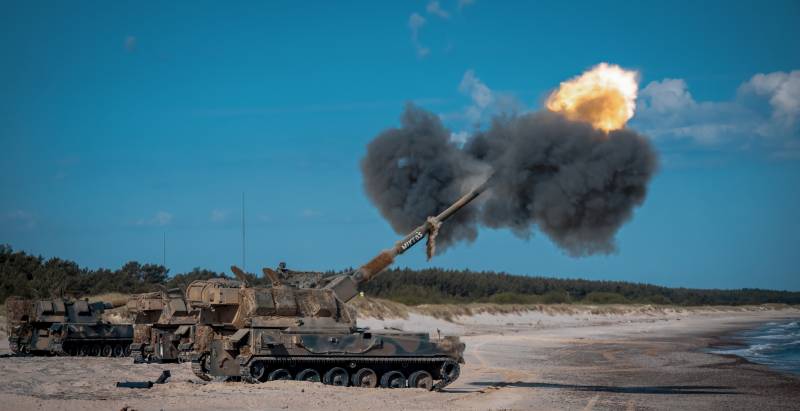
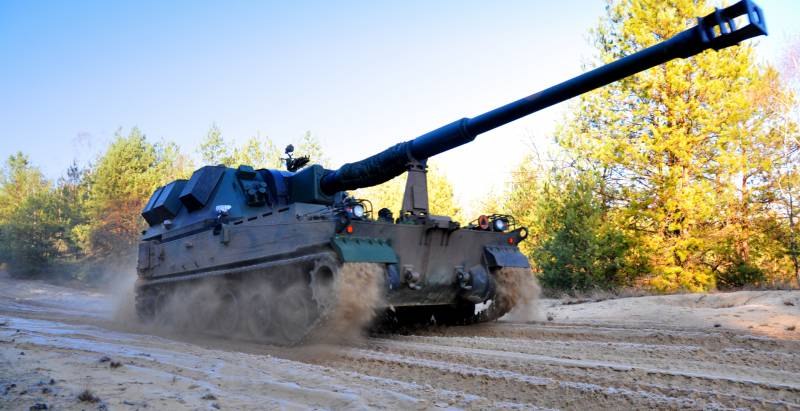
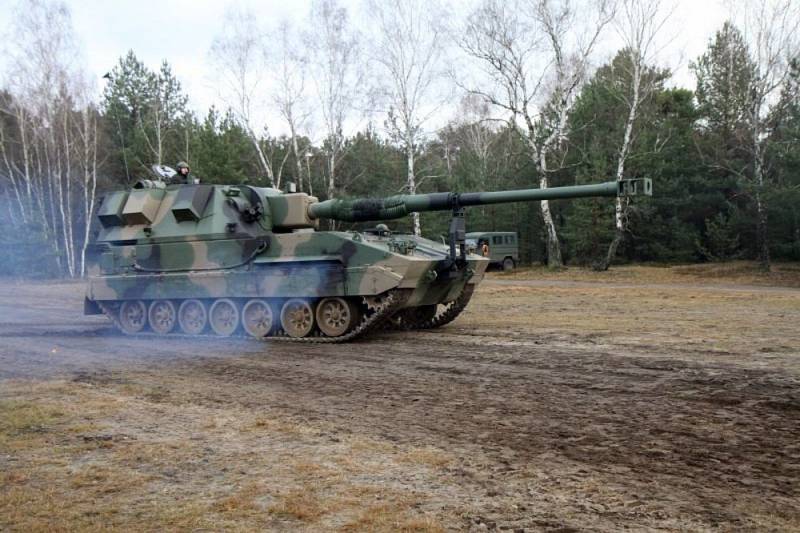
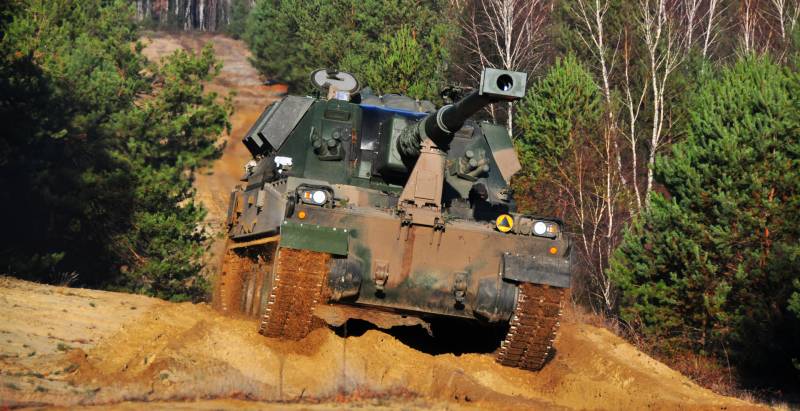
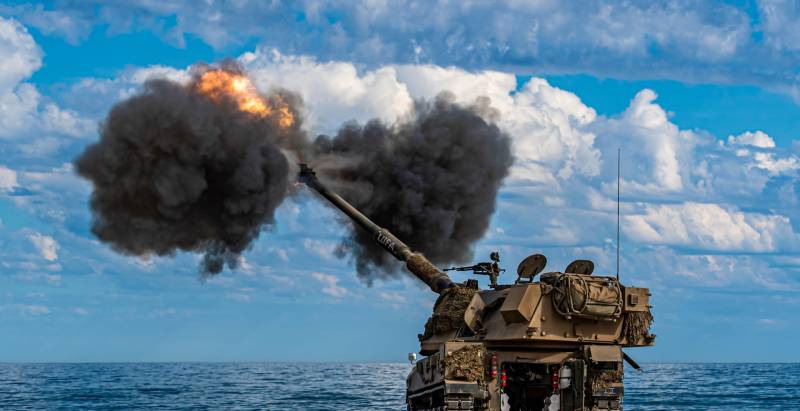
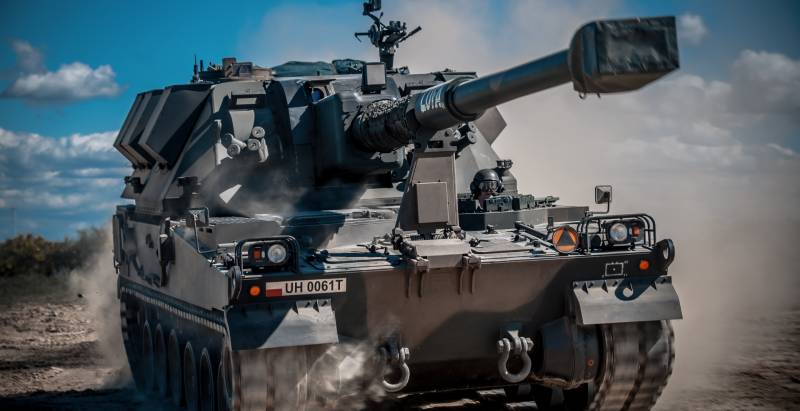
Information